There’s a good chance you can think of someone who plans on giving an Apple product this holiday season. Apple has rolled out its own Holiday Gift Guide and has its own gifting information page, which details the basics about gifting Apple products. If you’re looking for a little more assistance when shopping for Apple products then this guide is for you. Here we offer some simple tips to help the average holiday shopper save time and money when gifting Apple products.
Make Sure You Buy The Right Apple Device
Let’s face it, the average holiday shopper isn’t an expert technologist – they’re our parents, our grandparents, aunts, uncles, etc. Many will be first-time buyers of Apple products and will not know where to begin. If you need help choosing the right Apple product then consider these three tips, which should help give your hunt for the perfect gift some structure.
First, choose the right product family. Apple’s core product families are Mac (i.e. Apple’s desktop and laptop computers), iPad (i.e. iPad 2, iPad Mini, and iPad), iPhone (i.e. iPhone 4, iPhone 4S, and iPhone 5), and iPod (i.e. iPod Shuffle, iPod Nano, and iPod Touch). There are some products, which fall outside of these core families (i.e. Apple TV), but most fall under these four families. Apple’s own Holiday Gift Guide also organizes its flagship products in these four families so it makes sense to start here.
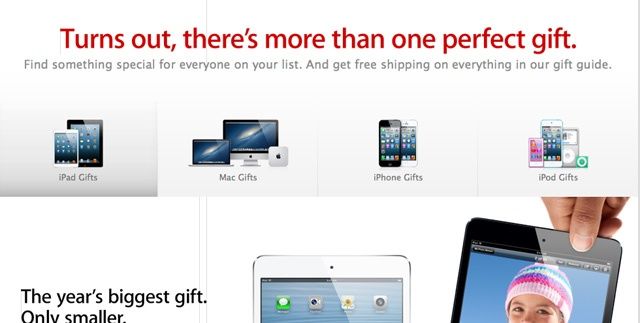
Chances are you already have a good idea of what product family your giftee wants (e.g. iPhone, iPad, MacBook, etc.). If you’re still unsure about where to start or can’t decide between two product families then consider visiting your local Apple Store – it’s always helpful to compare Apple products in-person. If you cannot get to an Apple Store consider contacting an Apple representative by telephone, chat, or email. If you have further questions feel free to email me. I’ll do my best to respond in a timely manner.
Second, don’t unwittingly buy the wrong model/generation. Apple further subdivides each of its product families into models, which are sometimes referred to as generations. An example of different models would be the iPhone 4, the iPhone 4S, and the iPhone 5. Apple product families are updated with newer models approximately once every year. For example, Apple released the iPhone 4 in 2010; Apple released the iPhone 4S in 2011; Apple released the iPhone 5 in 2012. For your reference Cult of Mac maintains a site devoted to tracking where each Apple product stands in its current product cycle.
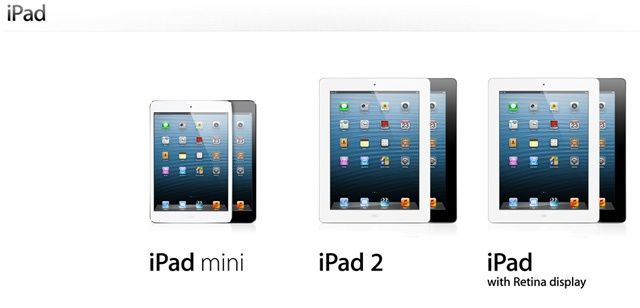
If you’re giving an Apple product as a gift then you will most likely want the latest model, but this may not always be the case. There is absolutely nothing wrong with buying an older or refurbished Apple product – Apple inspects and certifies each refurbished unit and they all carry the same One-Year Limited Warranty as the newest models. Pricing and availability may make an older or refurbished model your best choice, but the key here is that you don’t accidentally buy the wrong Apple model. If there is any question about the model be sure to ask before you purchase anything.
Third, choose the right configuration. I’ve written about this in past articles and my book. This task can be as easy, or as difficult, as you choose to make it. Differences to focus on include device size and weight, display type (e.g. Retina display vs. standard display), processor speed, amount of RAM, size and type of hard drive, and network capabilities (e.g. Wi-Fi, Cellular [3G, LTE], or both). Although discrete models’ configurations can most simply be broken down into “good,” “better,” and “best,” it would be a mistake to assume this is a foolproof approach. You need to compare different configurations.
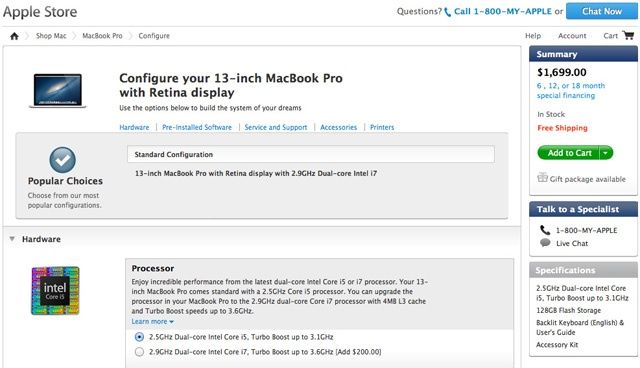
As a case in point, the iPad Mini Wi-Fi + Cellular configuration costs over $100 more than the iPad Mini Wi-Fi only configuration. Using the simplistic “good,” “better,” “best” approach to configurations may lead one to assume that the iPad Mini Wi-Fi + Cellular configuration is the “best” all around of the iPad Minis. In actuality the iPad Mini Wi-Fi only is every bit as good as the iPad Mini Wi-Fi + Cellular. It has the same processor, the same screen, and the same amount of storage. The only difference is that the iPad Mini + Cellular can connect to cellular data networks (for a monthly usage fee). This may be important for your giftee and, if so, then you will probably want this feature, but if it doesn’t matter (i.e. they only need Wi-Fi access) then perhaps you don’t need to spend the extra money.
The important point here is that you need to review the technical specifications of each configuration and ask questions if you’re not sure about whether a particular configuration includes everything you need. Only then can you be certain you’re getting the perfect gift without overspending.
Consider A Gift Card Instead
If you want to let the giftee do the shopping then consider giving Apple gift cards. Apple offers two types of gift cards: Apple Store gift cards (including iPhone gift cards) and iTunes gift cards (including App Store gift cards and iBookstore gift cards). You can use Apple Store gift cards to purchase tangible merchandise from any Apple Store or the online Apple Store. You can use iTunes gift cards to purchase media (i.e. music, movies, apps, OS X updates, etc.) from iTunes or the App Store. Therefore, if you’re looking to give a gift card to someone to buy a tangible Apple product (i.e. an iPad or iPod) you should give an Apple Store gift card. If, however, you are looking to supplement a gift of an Apple product then you may want to give an iTunes gift card.
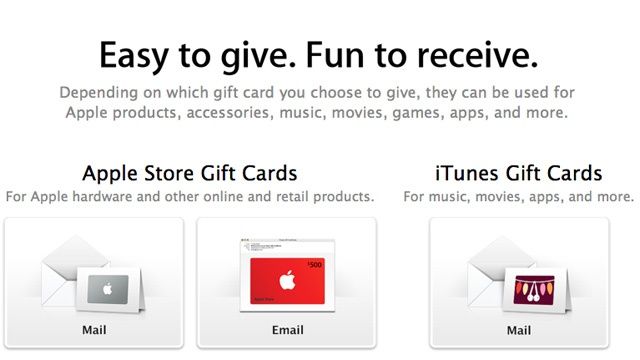
The consensus is that Apple gift cards purchased within the United States do not expire. This is Apple’s United States gift card policy, which it has likely employed in recent years because so many states have enacted legislation regarding expiration and fees associated with gift cards. This does not appear to be Apple’s policy in all countries, so buyers outside of the United States should check.
Don’t Procrastinate
Last-minute shoppers beware. Apple products (especially iPads) are looking to be one of the hottest holiday gifts this season. Some of the most popular products (e.g. iPhone 5, iPad, iPad Mini) are already in short supply and are already subject to shipping delays anywhere from 2-4+ weeks. The good news is that there still seems to be ample time to secure just about any Apple product by December 25th.
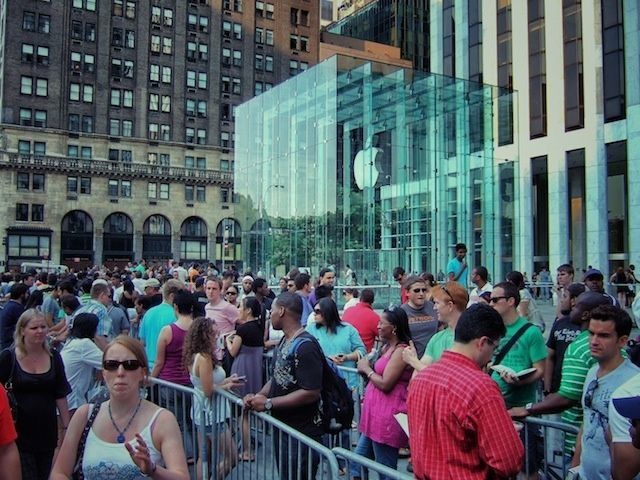
My advice: act fast. Figure out what product family, model, and configuration you need and purchase it directly from Apple as soon as possible. This is the surest and most convenient approach.
Try Reserving In-Store
You can reserve certain products (e.g. iPhone 5, iPad Mini) for in-store pickup on a nightly basis starting at 10:00 PM local time (of the Apple Store you’re seeking to pickup at). The window to reserve for in-store pickup remains open on a first-come, first-serve basis, so expect stiff competition. In-store reservations for iPhone 5s have been running out on a daily basis within a minute or less for each store, so this method will likely continue to be a long shot throughout the duration of the season.
Buy Direct From Apple
Apple has its act together when it comes to holiday shopping. Product supply issues may drive you toward other retailers and you’re certainly free to shop wherever you like, but buying direct from Apple has some advantages, which you should consider. There are two reasons why you should buy direct from Apple this holiday season: convenience and extremely favorable return policies.
First, buying direct from Apple is easy: all you need to do is find an Apple retail store. If you can’t get to an Apple Store just order online through the online Apple Store. Both options offer a superb experience, but those who are unsure about what Apple product to buy should make the effort to visit a brick-and-mortar Apple Store – there’s no substitute for the customer service and ability to see and hold the products in-person.
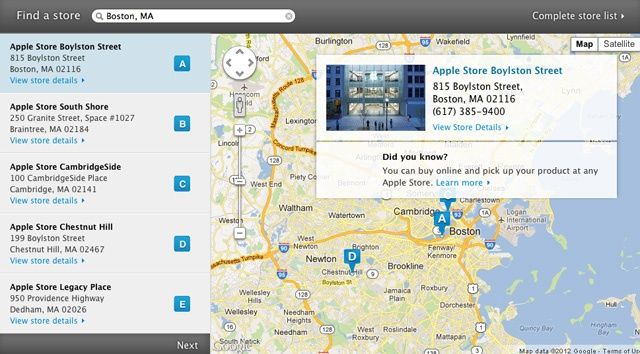
If you already know what to buy, cannot get to an Apple Store, need a highly-custom configuration, or are looking for deals on refurbished Apple products then the online Apple Store is where you want to go. Apple offers free standard shipping on most items ordered from its online Apple Store. Next day shipping typically costs extra, but Apple might decide to make next day shipping free for last-minute shoppers as it has done in previous years. Apple will also likely release a holiday order deadline schedule at some point in December, which it has done during previous holiday seasons.
Second, Apple’s relaxes its already favorable return policies during the holiday season, which is effective between October 27th and December 25th. You (or the giftee) are free to return any Apple product purchased direct from Apple during this time period through January 7th, 2013. According to Apple’s U.S. Retail Store Purchase Policies:
Items purchased at an Apple Retail Store between October 27, 2012, and December 25, 2012, may be returned with an original receipt or Gift Receipt through January 7, 2013. If the item is returned in the original box, with the original packaging, we will exchange it or offer you an Apple Gift Card. Refunds will be granted through January 7, 2013 only when an original purchase receipt is provided and will be based solely on the original method of payment.
All returns must include original packaging. Apple typically offers exchanges and refunds in the form of an Apple Store Gift Card even without a receipt, but if you want a cash refund you will also need the original purchase receipt; the receipt does not need to be a gift receipt (which you may request at the time of purchase) – a standard receipt will do.
Be On The Lookout For Holiday Deals
Many retailers will be offering discounts and specials deals on all sorts of Apple products. For example, Walmart has already announced that it will be offering a special deal on 16 GB Wi-Fi iPad 2s this season and its likely that many others will be offering discounts special deals. Cellular carriers will be selling iPhones and iPads equipped with cellular network capabilities. While there’s nothing wrong with shopping at a retailer other than Apple, you should be careful to research other retailers and review their return policies before making any purchase.
It’s impossible to be sure precisely what deals Apple will offer this year, but if last year’s holiday season is any preview then expect the following from Apple:
– Modest Black Friday discounts on many Apple products.
– Apple will probably begin to offer free shipping on all orders starting on Cyber Monday.
– Apple will likely offer free next day shipping during the final days leading up to December 25th.
Buy With A Credit Card That Offers Purchase Protection
Credit cards such as American Express offer extra purchase protection, which you may find helpful. These protection plans typically come at no additional cost and extend the life of manufacturer warranties. They also often offer other forms of protection such as accidental damage and theft protection for a period of time (i.e. 90-days) after purchase. If you’re going to be leaving that brand new 13” MacBook Pro with Retina display wrapped up under the Christmas tree for a few days then you may rest better knowing American Express will come to the rescue in the event of accident or theft.
Know If You Want AppleCare
Extended warranty care (AppleCare) is something you may want to purchase for your giftee. AppleCare comes in two flavors: standard AppleCare and AppleCare+. Both plans extend warranty coverage and offer technical support services, but AppleCare+ also gives some additional protection from accidental damage. The plans apply to different Apple products and have different procedures for obtaining coverage, so you should think about AppleCare/AppleCare+ before you make any purchase.
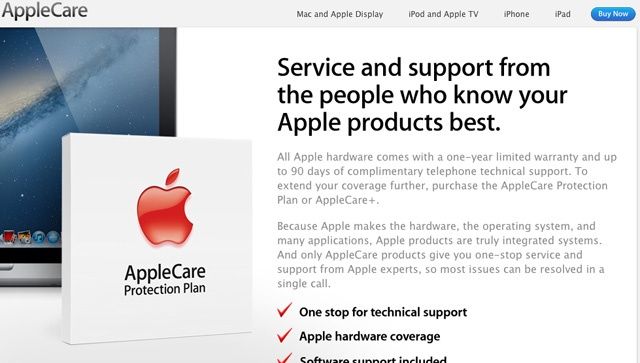
AppleCare+ is the only protection plan available for iPhones and iPads and it must either be bought at the time of purchase or within 30-days after purchase, provided you bring your device in for an inspection by a Genius at your local Apple Store. Standard AppleCare, on the other hand, is offered for all other Apple products and may be purchased, without an inspection, at any point within one year after the purchase of the product for which it is being purchased. You cannot get standard AppleCare coverage for iPhones or iPads.
As you can see, there is a greater sense of urgency for AppleCare+ when buying iPhones or iPads than standard AppleCare for other Apple products. Given the amount of time that may elapse between your purchase and the giftee’s receipt, you may want to consider buying AppleCare+ at the time of purchase. It would not surprise me if Apple makes exceptions in the short-term after the holiday, but I would not depend on it.
The prices for these plans do vary depending on the particular Apple product. My advice: think it over before you go out to buy anything – especially if you’re going to purchase an iPhone or iPad.
Skip The Engraving
Just don’t do it. Apple generally doesn’t accept returns or exchanges on “personalized” items at retail locations, which complicates the return process. Engraving your Apple device will also reduce its value in the event its owner ever decides to resell it.
Unboxing
If you have any say in how the giftee unboxes his or her new Apple product, then do your best to ensure that packaging materials are not lost or destroyed. You will need the original packaging if you want to return it. Moreover, Apple products retain their value very well and, therefore, the giftee may wish to sell it if they upgrade in a few years. Having the original packaging will make it easier to sell on the secondhand market (e.g. Craigslist, eBay, etc.).
Initial Inspection
It’s unlikely that your Apple product will be defective, but you should encourage the giftee to give his or her new device a thorough examination. At the very least, they should check to make sure there are not any signs of damage or obvious manufacturing defects such as scratches, cracks, misaligned or missing parts, etc.
If the Apple product is damaged or defective be sure to return it before the January 7th, 2013 deadline and demand a brand new replacement. You should not have to deal with warranty repair service when you are still within the return and exchange period.
Save The Date
Encourage the giftee to mark important dates related to their new Apple product on a calendar. Have them check their new Apple product’s warranty status and mark their calendar to remind two weeks before the One-Year Limited Warranty and (if applicable) AppleCare/AppleCare+ will expire. This can easily be done using the Calendar app. When the time comes, the giftee should conduct a thorough inspection of their Apple product and bring it in for service, if necessary, before the warranty or AppleCare expires.
Do you have other tips to offer our readers? If so, please post in the comments below.
![The Ultimate Beginner’s Guide For Gifting Apple Products [Holiday Shopping Guide] hgg-2011-cover-3](https://www.cultofmac.com/wp-content/uploads/2011/12/hgg-2011-cover-35.jpg)

